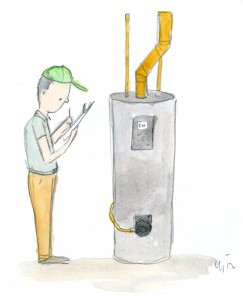Are You Ready to Buy Your First Home?

This post is brought to you by State Farm.
Thinking about buying your first home? Here’s how one couple began their house hunt, and their experience with the closing process and hiring a general contractor to remodel their home.
Nine months before their wedding date, Cat and Steve Hoang started thinking about buying their first home. At first, Cat, a 29-year-old marketing analyst living in Orange County, Calif. thought that buying a condo would make the most sense for their budget. A brand new condo would make a great starter home, she thought, and the couple could upgrade from there, but Steve disagreed.
“Steve really wanted a house we could live in for possibly the rest of our lives,” Cat said. “He thought a house would be a better investment because of the market right now. Housing prices are pretty low, and they’re going to eventually go up. We might not be able to afford an upgrade a few years from now, so we thought we should find the house we want to live in for a long time.”
With a house now in mind, Cat considered looking at tract homes in a gated community, which are popular in Orange County, but Steve pointed out that living in a gated community would mean having to pay homeowner association (HOA) fees. “Do we really want to be paying that for the rest of our lives?” he asked. They didn’t.
The couple sat down and talked about their must-haves, which would help them narrow down their search: They wanted a four-bedroom, two-story home in Orange County. They wanted the house to be near their workplaces, but also near Cat’s mom, who also lives in Orange County. Cat and Steve were planning on starting a family, and having Cat’s mother nearby to help watch the kids would be an enormous help. They looked at a few houses within their budget, but didn’t find anything they loved, and then stopped their hunt to focus on their wedding.
A year later, and now officially married, Cat and Steve resumed their hunt. Their budget was $500,000 to $550,000, and together, they had saved $100,000 for a 20 percent down payment by living with a roommate and putting as much of their paychecks as possible into an ING savings account for the last few years. (Cat’s motto during this time period was, “Saving is amazing.”)
Wanting to further cut down on costs, Cat and Steve decided to forego using a traditional real estate broker, and looked for houses themselves on Redfin, an online real estate brokerage site that allow buyers to search for homes on their own, reducing the costs and the amount of time brokers have to spend helping homeowners with their house hunt. Your average real estate agent typically earns a commission of about 3 percent of a home’s purchase price, but buyers who use Redfin can get a refund of up to 50 percent of that commission back in their pockets. For Cat and Steve, this would mean a savings of about $8,000.

But looking for their dream house on Redfin proved more difficult than they originally thought. Since this was the home they were probably going to live in forever, Cat and Steve were really picky. Most of the homes they saw were too small. They also looked at fixer-uppers, knowing that sellers of these homes were more inclined to sell as quickly as possible compared to homeowners who invested a lot of time and money into a property and wanted to make a big profit. They still struggled to find something they loved. After six months of looking, Cat’s parents offered to gift them some money, which pushed their budget to $600,000 and gave them a little bit more room to negotiate, but the homes they really liked were still out of their price range.
“We just couldn’t find anything,” Cat says. “We weren’t sure what we were going to do.”
They were finally able to find a house right in front of them: Steve’s parents owned two houses because his mom and dad worked in different parts of the state, and they decided it would make sense to sell their house in Orange County to Cat and Steve — if they liked it, of course. Though the house had nearly everything on their list of must-haves, it wasn’t aesthetically what they wanted. But Steve’s parents were also willing to sell them the house for $500,000, which was below the market value and a great deal, so they decided they’d buy the house and use the leftover money in their budget to fix it up to their liking. They were off to the bank, or banks, actually — it was time to shop around for a mortgage loan.
Chase, Bank of America, Wells Fargo, and a local credit union all offered the same mortgage rate of 3.625 percent. Steve’s father told Cat and Steve that he saw other banks offering interest rates as low as 2.6 percent, and when the couple asked lenders about the lower rate, they were told that it was more than likely that the rate was low because borrowers would have to buy it, meaning they’d give the bank money to “buy points” to lower their interest rate. Cat and Steve ran the numbers and decided that buying points to lower their interest rate would cost them more in the long run, especially if they decided to refinance in a few years.
“This is something you should really be cautious about,” Cat said. “You have to think really hard about the numbers.”
Cat and Steve decided to go with the general interest rate of 3.625 percent and chose Wells Fargo as their lender. Next came the escrow process, otherwise known as the “closing” process — the period of time between when the seller accepts a buyer’s bid, and when the buyers finally get the keys to move in. Cat and Steve put their deposit in an escrow account, and their escrow company, First American, acted as a neutral third party to collect all the paperwork and money involved in the closing, making sure everything is collected and done correctly, including the bank’s appraisal of the house, the home inspection, and the acquiring of homeowners insurance.

“There was so much paperwork,” Cat says. “We got so many drafts, probably two trees worth of drafts. I had one copy of the files, and Steve had another copy, and we looked at them separately to see what we could understand on our own. Steve and I compared notes on what we did or did not understand, and made a list of questions to ask our escrow agent. We ended up scheduling a one-hour teleconference with our agent and ran down our list of questions: ‘What is this dollar number here? What is this?’ That sort of thing. A lot of the time, the answer we got was, ‘You don’t need to know that.’ So we asked, ‘Okay, so what do we need to know? What should we worry about?’ You have put a lot of trust in them.”
The escrow process took about 30 days to complete, and the paperwork required 42 signatures and 22 initials. Starting this month, Cat and Steve are paying a total of $2,200 a month in mortgage, tax and insurance payments. They also have the option of paying biweekly, which would shorten their repayment period over the long run.
Now, that they’re officially homeowners, Cat and Steve are working on remodeling the house. They’re considering ripping down walls to create a more open floor plan, updating all the appliances in the kitchen, changing the carpet and the window treatments. They’ve met with six general contractors, four of whom were found on Craigslist, and two through recommendations from friends. Most of the general contractors were “yes men” — they said everything was possible to please the couple.
“Can we rip out this wall?” (“Yes.”)
“Can we move this stove here?” (Yes.”)
“Are you sure? Would you have to rewire the house?” (“Yes, don’t worry, we’ll take care of it.”)
They made it sound so easy. So Cat and Steve passed on each one. One contractor they met asked a lot of questions, and brought up issues that could arise during the remodeling, and was overall very thorough and patient. Cat and Steve has decided to hire him. They’re looking forward to settling in their new home.

Things of Note:
• Cat and Steve decided to forgo a broker because they felt comfortable about housing hunting on their own and wanted to save some money. Cat says her sister, “who is the type who wanted a lot more hand-holding” used a broker and was happy to have someone walk them through the entire process.
• It can be much harder to negotiate with sellers of newly-renovated homes because of all the time, money and effort the sellers have put in to make their home desirable for buyers. If you’re looking for a bargain a lot more room for negotiating, go for a fixer-upper.
• Cat and Steve wanted to have a 20 to 30 percent down payment on hand to get a desirable mortgage rate. It is possible to have a downpayment as low as 10 percent, but you’ll get less desirable rates.

Ten Really Fun House Buying Terms To Throw Around at Your Next Dinner Party
Appraisal
How much the house is worth according to a Professional Appraiser.
Assessed Value
How much the house is worth according to the city, so they can figure out how much tax money you have to pay.
Contingency
Stuff that has to happen in order for your contract to be binding (as in, you have to buy that thing). EXAMPLES: getting loan approval, passing inspection.
Equity
Value of house — balance of mortgage = equity (How much of the house you own.)
Escrow
Portion of the mortgage payment that is kept in a trust by the mortgage company to be used for taxes.
PITI
Principal, interest, taxes, and insurance. All the parts of a mortgage payment!
Fannie May
Private company created by Congress buys and sells mortgages, making them cheaper for borrowers.
Freddie Mac
Private company created by Congress; buys and sells mortgages, makingvthem cheaper for borrowers.
FHA Loan
Mortgage insured by the Federal Housing Administration (the premium is one to 3.8 percent of the loan, paid at closing). Allows people who can’t afford a down payment to get financing.
HUD-1
List of everything that has to be paid at closing.
Illustrations by Charrow, an artist in Brooklyn.
Sponsored posts are purely editorial content that we are pleased to have presented by a participating sponsor, advertisers do not produce the content.
Support The Billfold
The Billfold continues to exist thanks to support from our readers. Help us continue to do our work by making a monthly pledge on Patreon or a one-time-only contribution through PayPal.
Comments